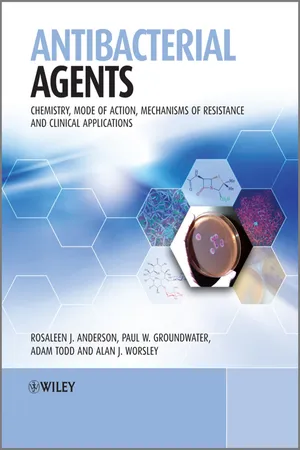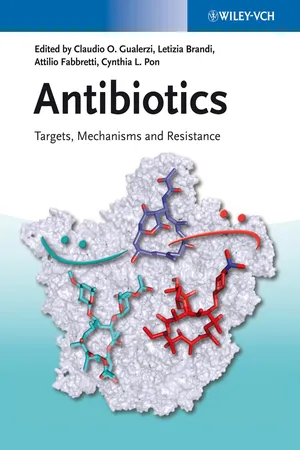Biological Sciences
Quinolones
Quinolones are a class of synthetic antibiotics that target bacterial DNA gyrase and topoisomerase IV, inhibiting DNA replication and leading to bacterial cell death. They are commonly used to treat a wide range of bacterial infections, including respiratory and urinary tract infections. Quinolones have a broad spectrum of activity and are known for their effectiveness against both Gram-negative and Gram-positive bacteria.
Written by Perlego with AI-assistance
Related key terms
5 Key excerpts on "Quinolones"
- eBook - ePub
Antibacterial Agents
Chemistry, Mode of Action, Mechanisms of Resistance and Clinical Applications
- Rosaleen Anderson, Paul W. Groundwater, Adam Todd, Alan Worsley(Authors)
- 2012(Publication Date)
- Wiley(Publisher)
Section 2 Agents Targeting DNA Antibacterial agents which target nucleic acids belong to the Quinolones (DNA gyrase/DNA topoisomerase IV inhibitors), rifamycins (DNA-dependent RNA polymerase inhibitors), or nitroimidazoles.Passage contains an image Chapter 2.1 Quinolone Antibacterial Agents
Key Points- The Quinolones are synthetic antibacterial agents which show greatest activity against Gram negative bacteria and are used in the treatment of urinary tract and respiratory infections.
- Resistance to Quinolones arises due to alterations in the DNA gyrase (via mutations in the quinolone resistance-determining region (QRDR) of the gyrA gene), and similar mutations which decrease quinolone binding have been described in topoisomerase IV (in the parC gene).
- The Quinolones are generally well tolerated, but some of the newer generations have been associated with serious adverse effects, such as hepatotoxicity and QT interval prolongation (cardiotoxicity).
- Some Quinolones should not be routinely used in combination with theophylline because of the risk of developing theophylline toxicity.
- For further information, see Emmerson and Jones (2003) and Hooper (1998).
Antibacterial Quinolones used clinically include nalidixic acid, ciprofloxacin, ofloxacin (racemic mixture of levofloxacin enantiomers), levofloxacin, norfloxacin, besifloxacin, and moxifloxacin; their structures are shown in Figure 2.1.1 and their therapeutic indications are listed in Table 2.1.1 .Figure 2.1.1 - eBook - ePub
Antibiotics
Targets, Mechanisms and Resistance
- Claudio O. Gualerzi, Letizia Brandi, Attilio Fabbretti, Cynthia L. Pon(Authors)
- 2013(Publication Date)
- Wiley-VCH(Publisher)
However, despite substantial pharmaceutical industry effort, DNA gyrase and topo IV have yet to realize their potential for new classes of drugs, as the fluoroQuinolones are the “only” class of marketed antibacterials acting on gyrase and topo IV. This does not necessarily highlight a limitation of the druggability of this target class, but rather may be a microcosm for the challenges and attrition in antibacterial drug discovery and development in general, and for novel inhibitor classes especially. Generally, the more novel the drug and target the greater opportunity for transformational drug development, but also the greater the possibility for myriad developability “surprises” that can derail a drug's development [136]. While several marketed fluoroQuinolones have been withdrawn (e.g., gatifloxacin, grepafloxacin, tosufloxacin, and trovafloxacin) [25], illustrating the challenges even for established drug families, the fluoroQuinolones remain a highly productive and promising class for exploration. This is exemplified by delafloxacin and JNJ-Q2, which are in phase 2, and show interesting potential for expanding the antibacterial spectrum of fluoroQuinolones to MRSA. Furthermore, on the basis of structural, biochemical, or genetic data, compounds such as quinazoline-2,4-diones, HITZ's, and QPT-1 demonstrate the exploitability of the fluoroquinolone mechanism by diverse chemistries. Interaction with GyrB rather than GyrA may explain the ability of these compounds to evade target-mediated cross-resistance with fluoroQuinolones, as shown by mutational data, and also shown structurally with the quinazoline-2,4-dione, PD 0305970.The recent discovery of the structural basis of action of Quinolones and NBTIs provides new learnings for the exploitation of DNA gyrase and topo IV, adding to the more established crystallography on the ATPase domain. Structure-based approaches can underpin the lead optimization of these inhibitor classes and help create new classes. The interfacial inhibition mechanisms of Quinolones, NBTIs, and other inhibitor classes are complex systems for de novo design and molecular modeling, as the environment is very dynamic, with different macromolecules moving within a complex molecular machine. Furthermore, the inhibition paradigm of Quinolones and NBTIs, as well as many other topoisomerase inhibitors, involves stabilization of complexes, and not “simple” competitive inhibition [137]. However, as more structural data emerges for different inhibitor classes acting at the DNA cleavage-religation site, more opportunities for knowledge-based approaches are likely. This stands to provide a “new twist” to the exploitation of this important drug target, for the discovery of badly needed new antibacterial agents.References
1. Talbot, G.H., Bradley, J., Edwards, J.E. Jr. Gilbert, D., Scheld, M., and Bartlett, J.G. (2006) Bad bugs need drugs: an update on the development pipeline from the Antimicrobial Availability Task Force of the Infectious Diseases Society of America. Clin. Infect. Dis., 42 - eBook - ePub
Antibiotics
Challenges, Mechanisms, Opportunities
- Christopher Walsh, Timothy Wencewicz(Authors)
- 2016(Publication Date)
- ASM Press(Publisher)
7.3a). A third generation (Fig. 7.3b) includes such approved molecules as moxifloxacin (Drlica and Zhao, 1997), gatifloxacin, and trovafloxacin, which was withdrawn due to life-threatening side effects. As of 2011, there was another set of FQs in clinical development (Fig. 7.3c). Because the Quinolones are fully synthetic scaffolds, amenable to synthesis, and because of the success of the early FQs, some tens of thousands of fluoroquinolone derivatives have been reported and more than two dozen have gone through clinical trials, reflecting the central place they have had over the past decades in the antibiotic space (Andriole, 2005). Figure 7.2 Structures of chloroquine and nalidixic acid. Nalidixic acid is an impurity isolated during the synthesis of chloroquine that was shown to have antibiotic properties. It is considered to be the first of the Quinolones. Figure 7.3 Second generation (a) and third generation (b) fluoroQuinolones and fluoroQuinolones currently in development (c). Each generation introduced different modifications (shown in red) to the original fluoroquinolone scaffold (shown in black) designed to improve efficacy. The targets of the various generations of quinolone antibiotics are type II topoisomerases (topo), and the antibiotics have played an important part in elucidation of the physiologic role of this topoisomerase class and in studies of mechanism of action (Wang, 1996). Bacteria have two related sets of topo II enzymes, DNA gyrase and topoisomerase IV. Each is an A 2 B 2 -type heterotetramer, with the gyrase subunits provided by GyrA and GyrB and the topo IV subunits composed of ParC and ParE. Some bacteria predominantly express the gyrAB genes, some the parCE genes, and some use both with overlap of apparent functions. DNA gyrase is the major enzyme regulating the supercoiling state of DNA in circular bacterial chromosomes (Higgins, 2007) - eBook - ePub
Bacterial Resistance to Antibiotics
From Molecules to Man
- Boyan B. Bonev, Nicholas M. Brown(Authors)
- 2019(Publication Date)
- Wiley-Blackwell(Publisher)
[3] . By this criterion, moxifloxacin would be a fourth‐generation quinolone and gatifloxacin would be in the first or second generation. Moreover, several important Quinolones lie outside our generational scheme. One is levofloxacin, a popular compound that shows activity with both Gram‐negative and Gram‐positive bacteria. The distinctive feature of levofloxacin is the fusion between the N‐1 and C‐8 substituents. This fused ring structure places levofloxacin between the third and fourth generations. Two newer agents, garenoxacin and gemifloxacin, also differ from the ciprofloxacin‐based lineage. Garenoxacin is noteworthy because it lacks the C‐6 fluorine characteristic of fluoroQuinolones.A variety of related compounds also form drug–topoisomerase–DNA complexes (Figure 6.1 , Table 6.2 ). We briefly comment on the quinazolinediones, because they have been used in resistance studies. Two general classes emerged from initial work, the 2,4‐diones and the 1,3‐diones. Both dione types lack the carboxyl group that is characteristic of the Quinolones. The absence of the carboxyl moiety renders the diones insensitive to the major resistance mutations in gyrA and parC [4 , 5 ].6.2 Mechanism of Action
6.2.1 Overview
Knowing how the Quinolones act provides a context for understanding resistance. A key observation is that the compounds are “concentration‐dependent killers.” Thus, raising their concentration improves the ability to eradicate an infecting pathogen population, to reduce the chance that new mutants will arise, and to kill resistant mutants that might already be present. Below we describe several steps in quinolone action that occur at different drug concentrations.At low quinolone concentrations, the drugs form bacteriostatic ternary complexes with DNA and either gyrase or topoisomerase IV; at higher concentrations, roughly above five‐times the MIC, the compounds kill rapidly growing cells within an hour or two. Rapid killing occurs by two lethal pathways (Figure 6.2 ). In one, bacteria respond to lethal lesions by generating ROS that accelerate cell death [7 , 8 ]. Killing by this pathway requires ongoing protein synthesis, which is required for ROS accumulation. Protein synthesis is also required for the chromosome fragmentation associated with nalidixic acid treatment. The second mode of killing, which is most prominent with the newest Quinolones (e.g., PD161144 with E. coli), occurs in the absence of growth, protein synthesis, or oxygen. Factors affecting rapid lethality are summarized in Table 6.3 - eBook - ePub
Chemistry and Medicines
An Introductory Text
- James R Hanson(Author)
- 2006(Publication Date)
- Royal Society of Chemistry(Publisher)
Staphylococcus aures (MRSA).6.11 SYNTHETIC ANTI-BACTERIAL AGENTS
Some synthetic anti-bacterial agents have been developed which act on nucleic acid transcription and replication. A family of Quinolones and fluoroQuinolones including nalidixic acid 6.49 and ciprofloxacin 6.50 have been discovered recently, which bind to DNA gyrase and prevent the coiling of DNA to form its tertiary structure. The widespread appearance of MRSA in hospitals has provided the stimulus for the synthesis of novel anti-bacterial compounds. A new class of antibacterial agents have been developed that contains an oxazolidinone ring and which inhibit protein synthesis in bacteria. These include linezolid 6.51 which was introduced as Zyvox® in 2001.For many years, it was thought that the presence of a nitro group in a drug would lead to toxicity. This arose because of the methaemoglobinaemia seen in munition workers exposed to trinitrotoluene. However, a number of anti-bacterial agents used for the treatment of urogenital infections such as nitrofurantoin and metronidazole 6.52 have been developed which contain this group.6.12 ANTI-VIRAL AGENTS
6.12.1 Viral Diseases
A number of diseases of man are of viral origin. These include poliomyelitis, common cold (rhinovirus), influenza, hepatitis A and B (liver disease), herpes simplex (cold sores), rubella and measles, papillomas (warts) and the human immunodeficiency virus (HIV-AIDS). A virus can rapidly mutate and hence different strains of the same virus can appear. These can have a different pathogenicity and immunity acquired against one strain may not be effective against another. This is common experience with the influenza virus.6.12.2 Viral Structure and Replication
The structure of the viral particle (viron) provides the basis for the treatment of viral infections. The virus 6.53
Learn about this page
Index pages curate the most relevant extracts from our library of academic textbooks. They’ve been created using an in-house natural language model (NLM), each adding context and meaning to key research topics.




